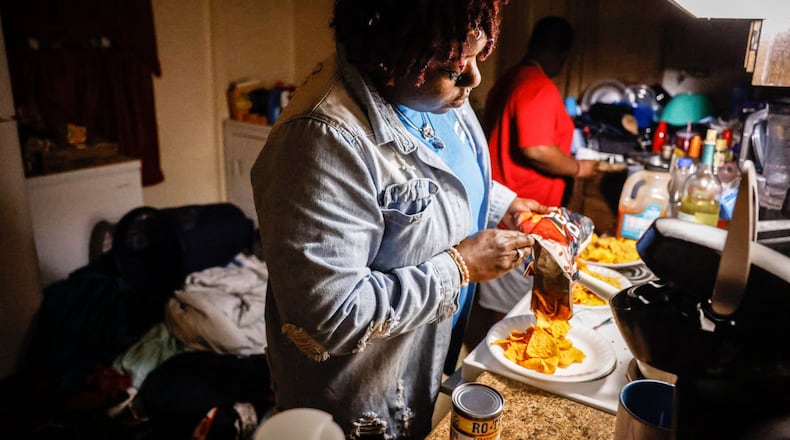“Especially with the Delta variant, we have lost a lot of young people,” said Dr. Median Ali, director of the intensive care unit at Sycamore Medical Center in Miamisburg.
September was the deadliest month of the coronavirus pandemic for Ohioans and Dayton-area residents under 50, according to a Dayton Daily News analysis of Ohio Department of Health data. August was the second deadliest month locally for the age group.
One loss during this summer wave was Willie Edwards Sr., 37, an RTA bus driver from Harrison Twp.
When Edwards Sr. died in late August from COVID-19, he left behind a gaping hole in the lives of his fiancee, five children, family, friends and the peewee football team he coached.
“It’s hard for the kids to talk about it. They say they miss him sometimes. So I have to go in a room when I’m crying,” said his fianceé, Ira Butler, a preschool teacher in Dayton. “To be honest, I’m still in shock because of how young he was. I would have never thought we would lose him to COVID.”
During a recent day in Butler’s home, their son, Willie Jr., 7, talked animatedly as he pointed out all the photos on the walls. Some are smiling group shots. Others are of Willie and his siblings playing sports. He pulled out a book of pictures of his father titled ‘Coach Will’ that a family friend put together and described each one, page by page.
“He’s in my heart,” he said.
Credit: JIM NOELKER
Credit: JIM NOELKER
Another son, William (Liam) Edwards, 4, sometimes says he misses his dad but he doesn’t really understand where his dad went. Anira Jacko, 14, and D’Angelo Jacko, 15, are more withdrawn when they talk about Edwards. They’re Butler’s children by another partner but Edwards has raised them most of their lives.
“It’s hard. He taught me a lot. Every time I think of him, I want to break down,” D’Angelo said. “He made me the man that I am today.”
At least 120 Ohio residents under 50 died in September from COVID-19, including two under 20 and 13 in their twenties. During the entire pandemic, 722 Ohioans under 50 have died. The previous one-month high for the age group was in December when 106 people died during a wave of the pandemic that preceded the wide rollout of vaccines and saw an overall death toll higher than the current wave’s.
Overall, residents under 50 have made up about 3% of pandemic deaths in Ohio; from June to September, however, they made up about 9%.
“Now we’re looking at people our same age,” said 34-year-old Sable Morgan, a nurse in the intensive care unit at Miami Valley Hospital. “And it makes it a lot more emotional, because a lot of these people have children at home the same age as your children. And you keep fighting and you keep fighting because these babies at home need their mom or their dad at home, you know, and when you lose that fight, you take it home with you and that makes it very, very tiring, very emotional. Lots of tears are shed on our unit.”
Credit: JIM NOELKER
Credit: JIM NOELKER
Coach Will
Edwards and Butler graduated from Trotwood-Madison High School. They reconnected in 2012 on Facebook. By then, she had two kids and he had one, Kayla Edwards, now 13.
“He was really, really good with the kids,” Butler said. “Kids loved him, all kids, not just his own.”
Butler said they were a close family that did everything together. Edwards liked spending time with Butler, playing with his youngest sons, taking his daughters on “girls trips” somewhere special, and coaching D’Angelo. Edwards also coached fifth-grade peewee football in Trotwood.
“He was a hard-working family man that really reached out to the community when he could,” Butler said.
In late July, the whole family got COVID-19. Butler suspects Edwards brought it home from work. The kids showed few symptoms. D’Angelo felt sick and Butler felt worse. Edwards complained his chest hurt. After four days, he went to Miami Valley Hospital and was told his oxygen was low.
Edwards already had some health issues, including asthma, high blood pressure and sleep apnea. But he was young and otherwise healthy so none of them imagined what would happen next.
Credit: JIM NOELKER
Credit: JIM NOELKER
He was admitted and put on a CPAP machine but it wasn’t enough. After a few days, Edwards was transferred to UC Health so he could be put on life support and a ventilator. He would need to be put in a medically-induced coma.
Since his family had COVID-19, they could not visit him in the hospital until they were clear of the virus.
“That made it even worse because he was fighting it alone at first,” Butler said.
Edwards called Butler before he was put into a coma. He told her he was scared and he loved her and the kids. Machines would keep him alive for the next three weeks.
After she cleared the virus, Butler would visit Edwards as often as she could, although it was difficult to be away from her kids and make the two-hour round-trip drive. Sometimes she brought the older kids but she never took Willie and Liam.
“I didn’t want them two to see him like that,” she said.
When they couldn’t make the trip, staff would place a phone by Edwards’ ear and allow the family to talk to him.
“They say that he could hear us,” Butler said. “So we talked to him. The kids talked to him. They said it would help.”
Hospital staff asked Edwards’ family if he died, should staff resuscitate him.
“At first we did,” Butler said. “It’s like, ‘we want you to do everything you can to save him,’ but then they started telling us, if they did compressions, or CPR, it would break his ribs and it would just make it worse and he would die a painful death. ... He wasn’t getting better, he was only getting worse so that’s why we had to take him off the machines. We ended up taking him off everything and he died as soon as we did.”
Edwards died Aug. 28.
“I cry so much,” Butler said. “Even a month later, it’s still hard to deal with.”
Credit: JIM NOELKER
Credit: JIM NOELKER
Edwards had talked about getting the coronavirus vaccine. After he fell ill, he did not express regret about not getting the shot. He didn’t have much time to think about it, Butler said.
A fundraiser for Butler and her kids can be found at gofund.me/d7f4256f.
Healthy people are dying
The spike in deaths of those under 50 is caused by the new strain of coronavirus.
“The majority of the people who are getting very sick are people with comorbidities, but the Delta variant is more contagious and actually can cause more severe disease, and more deadly outcomes,” Ali said.
Throughout the pandemic, false claims that nearly all COVID-19 deaths were of patients with comorbidities (a second disease or medical condition) have thrived. A study published in the American Journal of Managed Care from November found that, at the time, 17% of deceased COVID-19 patients had no comorbidities. And area health care workers say the number of otherwise healthy COVID-19 patients they’re seeing has increased.
Since the end of August, over 35% of patients admitted with COVID-19 to Dayton Children’s Hospital had no comorbidities.
“I think that’s the hardest part with COVID,” said Morgan. “There’s no rhyme or reason sometimes to who feels the effects and who it doesn’t affect. You can see somebody in here that you’re like, ‘oh man, they’ve got everything going against them and they end up walking out of here.’ And then you have other people that you’re like, ‘they should do great, they should do fine, they don’t have any comorbidities,’ and they don’t end up doing great. You just don’t know who it’s going to affect.”
There are also misconceptions that comorbidities that put a patient at risk are rare. Some of the diseases that increase the risk of hospitalization and death from COVID-19 — like obesity, diabetes and asthma — are common, affecting wide swaths of the U.S. population. Over 40% of American adults and 19% of American children are obese, over 10% of Americans have diabetes and over 8% have asthma, according to the CDC.
Treating this wave of younger people
Ali described treating an unvaccinated 37-year-old mother of four who fell ill with COVID-19.
“She got really very sick, we had to put her on life support and then we had to go through multiple setbacks,” he said. “We tried everything because we met the husband, we talked to the kids over the FaceTime. So we had that emotional connection, and eventually, unfortunately she couldn’t make it. And that was really very difficult on the nursing staff, on us as physicians, because these kids lost their mother forever to something that was preventable.”
Many health care workers on the front line of treating local COVID-19 patients are telling eligible people to get vaccinated to prevent serious illness and death.
“Regardless of the reason they didn’t take the vaccine, they are really decent people … and part of you wishes you could go back in time and tell them, ‘please get vaccinated, this is what is waiting for you,’” Ali said.
As of Wednesday, 86% of patients hospitalized with COVID-19 across Kettering Health and Premier Health were unvaccinated. In 2021, unvaccinated Ohioans have made up 98% of statewide COVID-19 deaths, according to the Ohio Department of Health.
“Be careful because even if you survive COVID because you’re young and healthy, you are at risk of getting long COVID or post-COVID syndrome, with chronic symptoms such as brain fog, shortness of breath, loss of taste and smell,” Ali said. “These things could last really for a long time, and I still see in my pulmonary clinic a good number of these patients who have scar tissue in their lungs.”
Three Montgomery County residents under 20 died this summer from COVID-19. While many young people who are admitted for coronavirus survive, it’s a life-changing event, said Karen Davis, a nurse in the intensive care unit at Dayton Children’s Hospital.
“I had a girl that everything I asked her to do to benefit her, she would do,” Davis said. “And so she would try to get up and go to the bathroom and her (oxygen) saturations would drop in the 70s. She would turn white, her lips would be blue. Watching them go through all those struggles is really hard being a mother and a grandmother myself.”
About the Author






